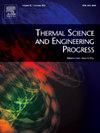Thermodynamic, techno-economic and environmental analysis with multi-objective optimization of an integrated solar-driven CAES unit with biofuel-driven gas turbine
IF 5.1
3区 工程技术
Q2 ENERGY & FUELS
引用次数: 0
Abstract
The present paper aims at development of a hybrid biomass-solar driven power generation plant based on biofuel-fired (using biomass gasification) gas turbine. Considering the limited biomass resources, the solar energy is used to provide required compressed air for the gas turbine unit via integration with Compressed Air Energy Storage (CAES) system which leads to reduced biomass usage and decreased CO2 emissions. Such a hybrid plant fulfills the intermittent nature of solar energy and the shortage of biomass resources. A gasification reactor is applied to convert solid biomass into gaseous bio-fuel to be combusted in the gas turbine. The feasibility analysis of developed hybrid configuration is carried out using the first and second thermodynamic laws. Then, environmental and economic considerations were taken into account in order to examine the hybrid plant performance. Parametric analyses are implemented to inspect key design parameters of the plant prior to multi-criteria optimization based on total system costs and exergy efficiency. The results indicated an interesting feature of solar energy incorporation. It is found that, if the solar energy share in hybrid plant is increased the produced power cost would be decreased, despite increased total capital costs. Under the optimal operation obtained via multi-criteria optimization, the hybrid plant achieves exergy efficiency of 39.60% with 45.21 $/h total system cost rate.
太阳能驱动CAES机组与生物燃料驱动燃气轮机集成的热力学、技术经济和环境分析与多目标优化
本文旨在开发一种基于生物燃料(利用生物质气化)燃气轮机的生物质-太阳能混合发电装置。考虑到有限的生物质资源,通过与压缩空气储能(CAES)系统集成,利用太阳能为燃气轮机机组提供所需的压缩空气,从而减少生物质的使用,减少二氧化碳的排放。这种杂交植物满足了太阳能的间歇性和生物质资源的短缺。采用气化反应器将固体生物质转化为气态生物燃料,在燃气轮机中燃烧。利用热力学第一定律和热力学第二定律对所开发的混合结构进行了可行性分析。然后,考虑环境和经济因素,以检验杂交植物的性能。在基于系统总成本和能源效率的多准则优化之前,对电厂的关键设计参数进行了参数分析。结果显示了太阳能吸收的一个有趣的特征。研究发现,增加太阳能在混合电厂中的份额,在总资本成本增加的情况下,发电成本会降低。在多准则优化得到的最优运行下,混合电厂的火用效率为39.60%,系统总成本率为45.21美元/小时。
本文章由计算机程序翻译,如有差异,请以英文原文为准。
求助全文
约1分钟内获得全文
求助全文
来源期刊

Thermal Science and Engineering Progress
Chemical Engineering-Fluid Flow and Transfer Processes
CiteScore
7.20
自引率
10.40%
发文量
327
审稿时长
41 days
期刊介绍:
Thermal Science and Engineering Progress (TSEP) publishes original, high-quality research articles that span activities ranging from fundamental scientific research and discussion of the more controversial thermodynamic theories, to developments in thermal engineering that are in many instances examples of the way scientists and engineers are addressing the challenges facing a growing population – smart cities and global warming – maximising thermodynamic efficiencies and minimising all heat losses. It is intended that these will be of current relevance and interest to industry, academia and other practitioners. It is evident that many specialised journals in thermal and, to some extent, in fluid disciplines tend to focus on topics that can be classified as fundamental in nature, or are ‘applied’ and near-market. Thermal Science and Engineering Progress will bridge the gap between these two areas, allowing authors to make an easy choice, should they or a journal editor feel that their papers are ‘out of scope’ when considering other journals. The range of topics covered by Thermal Science and Engineering Progress addresses the rapid rate of development being made in thermal transfer processes as they affect traditional fields, and important growth in the topical research areas of aerospace, thermal biological and medical systems, electronics and nano-technologies, renewable energy systems, food production (including agriculture), and the need to minimise man-made thermal impacts on climate change. Review articles on appropriate topics for TSEP are encouraged, although until TSEP is fully established, these will be limited in number. Before submitting such articles, please contact one of the Editors, or a member of the Editorial Advisory Board with an outline of your proposal and your expertise in the area of your review.
 求助内容:
求助内容: 应助结果提醒方式:
应助结果提醒方式:


